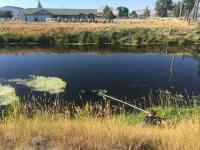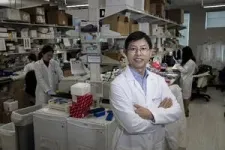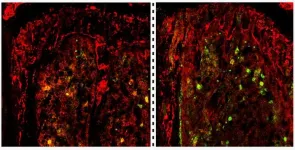(Press-News.org) Different cyanobacterial species produce different toxins, said OSU’s Kimberly Halsey, who led the study. Most of them cause gastrointestinal illness and acute skin rashes, and they can be deadly. In 2017, more than 30 cattle died after drinking contaminated water at Junipers Reservoir near Lakeview, Oregon, and blooms particularly pose a threat to dogs entering affected lakes.
Even though the research dealt with just one lake and one toxin, the research demonstrates VOCs’ potential in monitoring critical waterways, said Halsey, associate professor of microbiology in the College of Science.
She said the study published today in mSystems describes “a very creative new approach that’s better and less expensive than current monitoring methods and also has broader implications.”
“This work suggests that VOCs might be used to indicate other important environmental shifts, like the onset of oxygen deficiencies in aquatic systems or domoic acid contamination in coastal ecosystems,” Halsey said.
Further research, including collaborations with the city of Salem and Eugene Water and Electric Board, will explore whether the gaseous molecules can be used to predict the start and end of toxicity within a bloom event.
VOCs are any of a number of carbon-containing chemicals with a high tendency to exist in their gaseous state. VOCs released by cyanobacteria seem to reveal the physiological status of the algae during toxic blooms, Halsey said.
“One reason VOCs could be such great targets for monitoring is their volatility,” she said. “Ideally we’ll someday be able to sniff the air above the lake with instruments and see which gases are there during cyanobacterial blooms.”
Cyanobacteria are microscopic organisms ubiquitous in all types of water around the globe. They use sunlight to make their own food and in warm, nutrient-rich environments can quickly multiply, resulting in blooms that spread across the water’s surface.
These harmful algal blooms, often abbreviated to HABs, can form at any time of the year but most typically happen between spring and fall.
An HAB in 2018 fouled drinking water in Oregon’s capital city of Salem, and in 2007 a national survey by the U.S. Environmental Protection Agency found microcystin, a recognized liver toxin and potential liver carcinogen, in one out of every three lakes that were sampled.
Annual economic losses attributed to cyanobacterial HABs in the United States alone are conservatively valued at $2-4 billion, say the researchers, who add that the severity and consequences of the blooms are likely to be exacerbated by climate change.
“That means we need new and innovative monitoring for cyanobacteria and their toxins,” Halsey said. “It’s super expensive to measure toxins directly, especially when a waterway needs to be sampled and tested weekly over the course of an entire summer.”
Different cyanobacterial species produce different toxins, Halsey said. Most of them cause gastrointestinal illness and acute skin rashes, and they can be deadly. In 2017, more than 30 cattle died after drinking contaminated water at Junipers Reservoir near Lakeview, Oregon, and blooms particularly pose a threat to dogs entering affected lakes.
Halsey, microbiology graduate student Lindsay Collart and associate professor of statistics Duo Jiang worked with two years of water samples from eight locations on and near Upper Klamath Lake in southern Oregon.
The lake is important for agriculture and recreation, for tribal subsistence and culture, and for fish and wildlife, Halsey notes, but its water quality has declined over the last 50 years from intensive farming and drought.
Upper Klamath Lake is one of many Oregon lakes affected by cyanobacterial HABs each year, but not all of the blooms result in toxic levels of microcystin, and the onset and levels of toxin production have been largely unpredictable.
“The algae cells are always producing a little bit of microcystin, and it serves a good purpose in the cell – it helps combat stress,” Halsey said. “But the cells can reach a tipping point of over-reliance on microcystin and that’s when levels in the water become toxic.”
Analyzing the dissolved gases in the water samples – 227 VOCs in all – the scientists were able to determine subsets of them that were associated with different levels of microcystin in the water. Statistical analysis of the VOC subsets does a better job predicting toxin levels than currently used techniques like assessing water color and measuring cell count, Halsey said.
“Now that we know these particular subsets of compounds are predictors of toxicity, maybe we only need to measure those,” she said.
Even though the study dealt with just one lake and one toxin, the research demonstrates VOCs’ potential in monitoring critical waterways, Halsey said. Further research, including collaborations with the city of Salem and Eugene Water and Electric Board, will explore whether the gaseous molecules can be used to predict the start and end of toxicity within a bloom event.
Halsey said the study also showed that VOCs can be used to paint a general picture of community composition – i.e., the relative abundance of cyanobacteria to other microbes in the system – which she describes as potentially “another piece of the prediction puzzle.”
The Oregon State College of Science and the OSU Agricultural Research Foundation supported this research.
END
Oregon State researchers develop novel technique for sniffing out toxic algae blooms
2023-08-17
ELSE PRESS RELEASES FROM THIS DATE:
New research: Political attitudes did not change during COVID-19 pandemic
2023-08-17
EAST LANSING, Mich. – There is a traditional understanding that if someone experiences a threatening event, their attitudes and beliefs will change. Some scholars predict that a threat will cause someone to become more conservative on a variety of issues or that they will become more extreme in their attitudes. However, a new study from researchers at Michigan State University and Tilburg University found that Americans’ political attitudes did not change significantly during the onset of the COVID-19 pandemic, contrary to ...
RESEARCH ALERT: City of Hope scientists unravel how TET2 gene deficiency fuels development of acute myeloid leukemia
2023-08-17
FINDINGS
Scientists at City of Hope, one of the largest cancer research and treatment organizations in the United States, have identified how low levels of the TET2 gene fuel the rapid growth of acute myeloid leukemia in animal models. Cell Stem Cell recently published the study.
A team led by Jianjun Chen, Ph.D., the Simms/Mann Family Foundation Chair in Systems Biology at Beckman Research Institute of City of Hope, found that TET2 deficiency sets off a cascade of biochemical changes that enhance the bone marrow cancer’s ability to spread. These changes ...
Sean Jones appointed Argonne’s Deputy Laboratory Director for Science and Technology
2023-08-17
The U.S. Department of Energy’s Argonne National Laboratory has named Sean Jones as deputy laboratory director for science and technology. Jones will begin his new role on October 9, serving as Argonne’s senior science strategist, advisor and chief research officer.
Jones will join Argonne from the National Science Foundation (NSF). In his current role as Assistant Director of the NSF’s Mathematical and Physical Sciences directorate, he oversees a $1.86 billion portfolio that includes five science divisions, domestic and international research facilities, and ...
Carrier receives International Award for Outstanding Leadership
2023-08-17
Julie Carrier, professor and head of the University of Tennessee Department of Biosystems Engineering and Soil Science, was awarded the James R. and Karen A. Gilley Academic Leadership Award during the annual international meeting of the American Society of Agricultural and Biological Engineers (ASABE) in July.
The award was given in recognition of Carrier’s exceptional leadership as department head as well as her ongoing dedication to furthering the UT Institute of Agriculture’s mission to provide research and extension ...
Policies favoring high-volume hospitals may disadvantage rural cancer patients
2023-08-17
PITTSBURGH, Aug. 17, 2023 – Patients with cancer who live in rural Pennsylvania counties appear to know that they may have better outcomes if they receive their cancer surgery at a hospital that performs a high volume of those surgeries, but still opt for lower volume hospitals closer to home when their cancer is likely less complex, according to a new analysis published today in JCO Oncology Practice by health policy scientists at the University of Pittsburgh School of Public Health.
With a shortage of experienced surgeons in rural America and rural ...
Racial and ethnic differences in gut microbiome emerge at 3 months old
2023-08-17
Gut microbiome variation associated with race and ethnicity arises after three months of age and persists through childhood, according to a new study published August 17th in the open access journal PLOS Biology by Elizabeth K. Mallott of Washington University in St. Louis, US, Seth Bordenstein of Pennsylvania State University, US, and colleagues.
Human microbiome variation has been linked to the incidence, prevalence and mortality of many diseases and is known to associate with race and ethnicity in the United States. However, in this context race and ethnicity are considered proxies for inequitable exposure to social and environmental determinants of health due to structural racism. ...
Economist group argues for scientific experimentation in environmental policymaking
2023-08-17
Environmental regulators and other organizations should do more scientific experimentation to inform natural resource policy, according to an international group of economists that includes University of Wyoming researchers.
In a new paper in the prestigious journal Science, the economists say more frequent use of up-front experiments would result in more effective environmental policymaking in areas ranging from pollution control to timber harvesting across the world.
“Although formal experimentation is a cornerstone of science and is increasingly embedded in nonenvironmental social programs, it is virtually absent in environmental ...
LRT, REM, mass transit projects and their fuzzy reality
2023-08-17
The city of Gatineau is planning a tramway network that will link up with Ottawa, where the Light Rail Transit (LRT) continues to be bogged down by major mishaps. With Montreal’s new Réseau express métropolitain (REM) light transit system experiencing its own hiccups to start, how can cities looking to incorporate mass transport systems successfully launch such endeavors while avoiding project failures and years of misfortune?
New research from a University of Ottawa professor suggests project leaders not overlook the “F” word.
Telfer School of Management professor Lavagnon Ika found a lack of full appreciation ...
You’re reading this because an asteroid killed the dinosaurs, allowing mammals to dominate the Earth. But why?
2023-08-17
Almost 66 million years ago, an asteroid struck the Earth, killing all non-avian dinosaurs and allowing mammals to dominate.
But just how did we evolve from rat-like creatures running between the feet of dinosaurs to take over their ecological niches? Dr. Kendra Chritz, assistant professor in the UBC department of earth, ocean and atmospheric sciences, aims to find out.
Dr. Chritz is co-leading a new multi-million-dollar research project to learn how ecosystems and organisms recover after a catastrophic, climate-changing event. She explains in this Q&A that clues may lie in the fossilized teeth of mammals.
Why don’t we know much about how mammals ...
Study uncovers potential new source of genetic mutations that cause neurodegenerative disease
2023-08-17
Scientists have discovered an additional potential cause of the genetic mutations that result in rare conditions such as Huntington’s disease (HD).
The neurodegenerative diseases, which also include most spinocerebellar ataxias (SCAs), are known to be caused by an expansion in the CAG (cytosine-adenine-guanine) repeats within a gene that in turn leads to an expanded polyglutamine (polyQ) tract in a protein.
Such diseases are inherited, given that the expansion of CAG repeats in a gene can be passed down the generations.
Previously, it had been thought the damage in these genetic diseases was caused solely by increased protein aggregate toxicity.
However, ...






